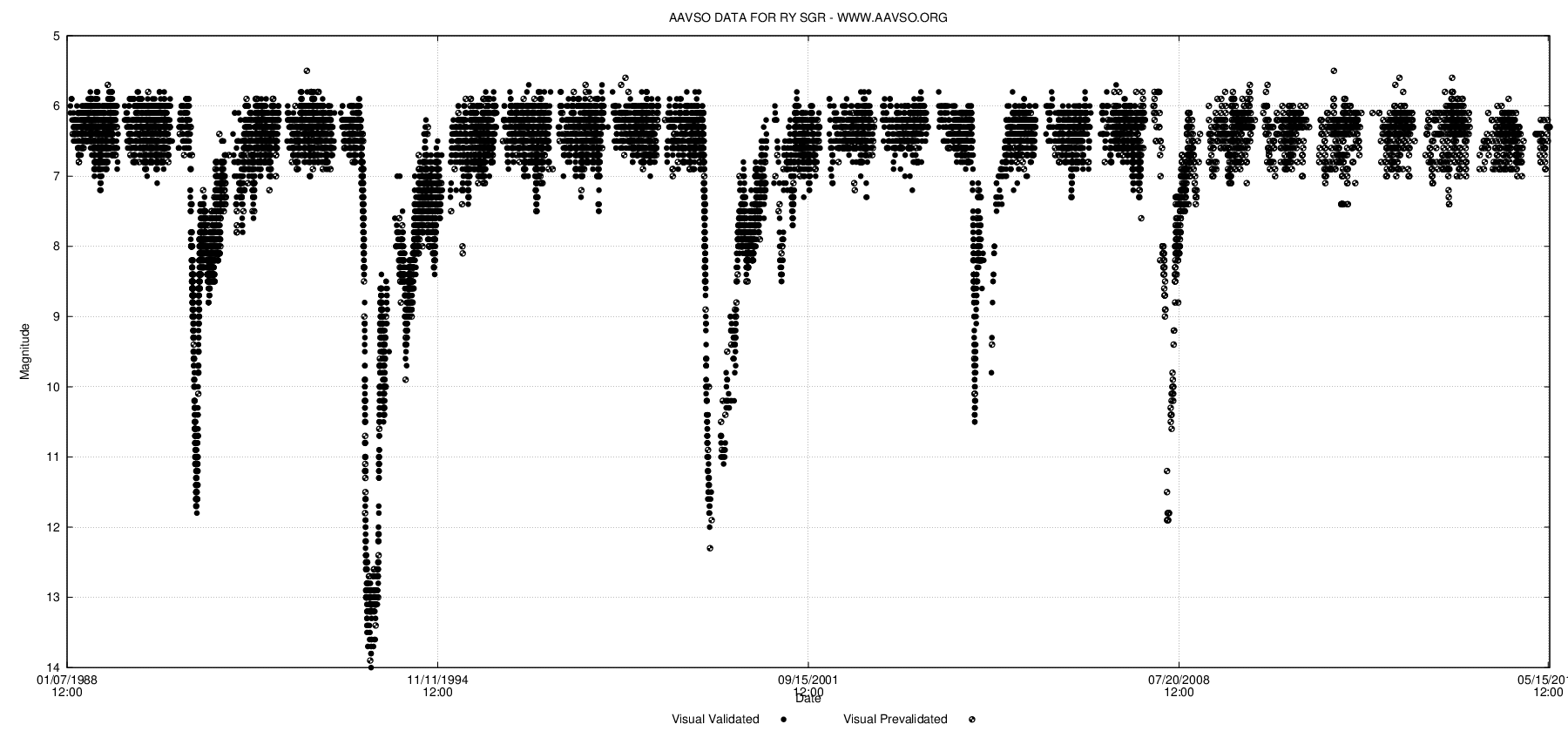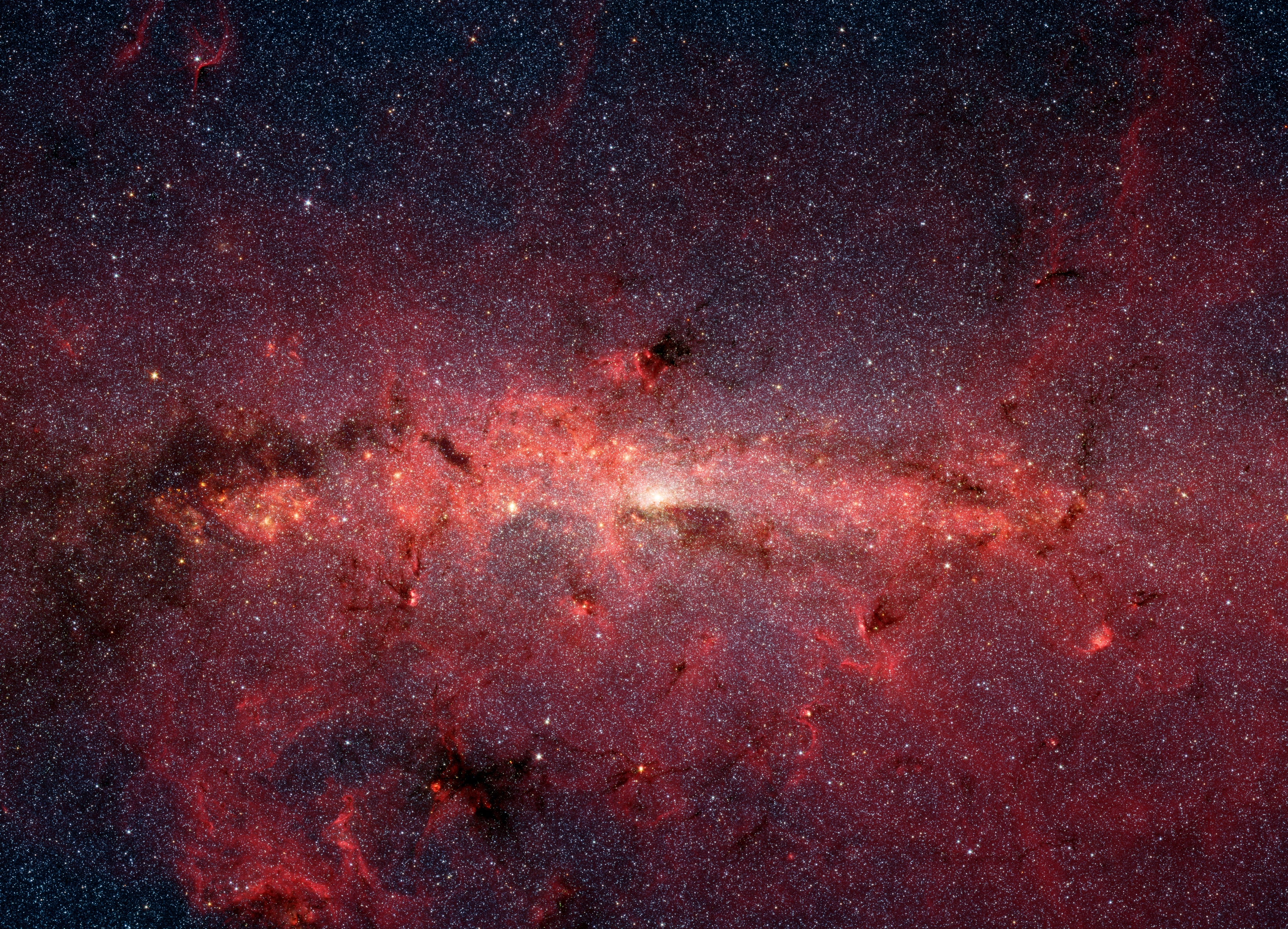|
W Mensae
W Mensae (W Men) is an unusual yellow supergiant star in the Large Magellanic Cloud in the southern constellation Mensa. It is an R Coronae Borealis variable and periodically decreases in brightness by several magnitudes. W Men is very distant, being located in the neighboring galaxy Large Magellanic Cloud, where it lies on the southern metal-deficient edge. Despite its high luminosity, the star has a maximum apparent brightness of +13.8m, too dim to be visible in a small telescope. Its radius has been calculated to be 61 times that of the Sun. The variability of W Men was discovered in 1927 by W. J. Luyten. It belongs to the very rare R Coronae Borealis R Coronae Borealis is a low-mass yellow supergiant star in the constellation of Corona Borealis. It is the prototype of the R Cor Bor class of variable stars, which fade by several magnitudes at irregular intervals. R Coronae Boreali ... class of variables which are often called "inverse novae" since ... [...More Info...] [...Related Items...] OR: [Wikipedia] [Google] [Baidu] |
Large Magellanic Cloud
The Large Magellanic Cloud (LMC), or Nubecula Major, is a satellite galaxy of the Milky Way. At a distance of around 50 kiloparsecs (≈160,000 light-years), the LMC is the second- or third-closest galaxy to the Milky Way, after the Sagittarius Dwarf Spheroidal (16 kpc) and the possible dwarf irregular galaxy known as the Canis Major Overdensity. Based on the D25 isophote at the B-band (445 nm wavelength of light), the Large Magellanic Cloud is approximately across. It is roughly a hundredth as massive as the Milky WayMagellanic Cloud . ''''. 2009. Encyclopædia Britannica Online. 30 Aug. 2009. and is the fourth-largest g ... [...More Info...] [...Related Items...] OR: [Wikipedia] [Google] [Baidu] |
Extragalactic Stars
Extragalactic astronomy is the branch of astronomy concerned with objects outside the Milky Way galaxy. In other words, it is the study of all astronomical objects which are not covered by galactic astronomy. The closest objects in extragalactic astronomy include the galaxies of the Local Group, which are close enough to allow very detailed analyses of their contents (e.g. supernova remnants, stellar associations). As instrumentation has improved, distant objects can now be examined in more detail and so extragalactic astronomy includes objects at nearly the edge of the observable universe. Research into distant galaxies (outside of our local group) is valuable for studying aspects of the universe such as galaxy evolution and Active Galactic Nuclei (AGN) which give insight into physical phenomena (e.g. super massive black hole accretion and the presence of dark matter). It is through extragalactic astronomy that astronomers and physicists are able to study the effects of General ... [...More Info...] [...Related Items...] OR: [Wikipedia] [Google] [Baidu] |
F-type Supergiants
F-type may refer to: *F-type asteroid, a type of carbonaceous asteroid *F-ATPase, a membrane protein *F-type main-sequence star, a hydrogen-fusing star *F-type Prisons, high-security prisons in Turkey *MG F-type Magna, six-cylinder-engined car produced by the MG Car company from October 1931 to 1932 *Jaguar F-Type, a two-seat sports car manufactured by Jaguar Cars *Renault F-Type engine, straight-4 automobile engine from Renault * Empire F type coaster, a type of prefabricated coastal tanker built in the UK during the Second World War * F connector, a commonly used connector for coaxial cable See also *F class (other) *B type (other) B type or Type B may refer to: Astronomy * B-type asteroid, a type of relatively uncommon type of carbonaceous asteroid * B-type giant, a type of blue giant star * B-type star, a type of star Biology * B type blood, a type in the ABO blood group ... * P-type (other) {{disambiguation ... [...More Info...] [...Related Items...] OR: [Wikipedia] [Google] [Baidu] |
R Coronae Borealis Variables
An R Coronae Borealis variable (abbreviated RCB, R CrB) is an eruptive variable star that varies in luminosity in two modes, one low amplitude pulsation (a few tenths of a magnitude), and one irregular, unpredictably-sudden fading by 1 to 9 magnitudes. The prototype star R Coronae Borealis was discovered by the English amateur astronomer Edward Pigott in 1795, who first observed the enigmatic fadings of the star. Only about 150 RCB stars are currently known in our Galaxy while up to 1000 were expected, making this class a very rare kind of star. It is increasingly suspected that R Coronae Borealis (RCB) stars – rare hydrogen-deficient and carbon-rich supergiant stars – are the product of mergers of white-dwarfs in the intermediary mass regime (total mass between 0.6 and 1.2 ). The fading is caused by condensation of carbon to soot, making the star fade in visible light while measurements in infrared light exhibit no real luminosity decrease. R Coronae Borealis variables are ... [...More Info...] [...Related Items...] OR: [Wikipedia] [Google] [Baidu] |
Stars In The Large Magellanic Cloud
A star is an astronomical object comprising a luminous spheroid of plasma held together by its gravity. The nearest star to Earth is the Sun. Many other stars are visible to the naked eye at night, but their immense distances from Earth make them appear as fixed points of light. The most prominent stars have been categorised into constellations and asterisms, and many of the brightest stars have proper names. Astronomers have assembled star catalogues that identify the known stars and provide standardized stellar designations. The observable universe contains an estimated to stars. Only about 4,000 of these stars are visible to the naked eye, all within the Milky Way galaxy. A star's life begins with the gravitational collapse of a gaseous nebula of material composed primarily of hydrogen, along with helium and trace amounts of heavier elements. Its total mass is the main factor determining its evolution and eventual fate. A star shines for most of its active life due ... [...More Info...] [...Related Items...] OR: [Wikipedia] [Google] [Baidu] |
Nova
A nova (plural novae or novas) is a transient astronomical event that causes the sudden appearance of a bright, apparently "new" star (hence the name "nova", which is Latin for "new") that slowly fades over weeks or months. Causes of the dramatic appearance of a nova vary, depending on the circumstances of the two progenitor stars. All observed novae involve white dwarfs in close binary systems. The main sub-classes of novae are classical novae, recurrent novae (RNe), and dwarf novae. They are all considered to be cataclysmic variable stars. Classical nova eruptions are the most common type. They are likely created in a close binary star system consisting of a white dwarf and either a main sequence, subgiant, or red giant star. When the orbital period falls in the range of several days to one day, the white dwarf is close enough to its companion star to start drawing accreted matter onto the surface of the white dwarf, which creates a dense but shallow atmosphere. This atmosphe ... [...More Info...] [...Related Items...] OR: [Wikipedia] [Google] [Baidu] |
Willem Jacob Luyten
Willem Jacob Luyten (March 7, 1899 – November 21, 1994) was a Dutch-American astronomer. "Willem Jacob Luyten", ''Marquis Who's Who'', 2006. Life Jacob Luyten was born in Semarang, Java, at the time part of the Dutch East Indies. His mother was Cornelia M. Francken and his father Jacob Luyten, a teacher of French. At the age of 11 he observed Halley's Comet, which started his fascination with astronomy. He also had a knack for languages, and eventually could speak nine. In 1912 his family moved back to the Netherlands where he studied astronomy at the University of Amsterdam, receiving his BA in 1918. He was the first student to earn his PhD (at the age of 22) with Ejnar Hertzsprung at Leiden University. In 1921 he left for the United States where he first worked at the Lick Observatory. From 1923 to 1930 Luyten worked at the Harvard College Observatory eventually working at the observatory's Bloemfontein station. He spent the years 1928–1930 in Bloemfontein, South ... [...More Info...] [...Related Items...] OR: [Wikipedia] [Google] [Baidu] |
Telescope
A telescope is a device used to observe distant objects by their emission, absorption, or reflection of electromagnetic radiation. Originally meaning only an optical instrument using lenses, curved mirrors, or a combination of both to observe distant objects, the word ''telescope'' now refers to a wide range of instruments capable of detecting different regions of the electromagnetic spectrum, and in some cases other types of detectors. The first known practical telescopes were refracting telescopes with glass lenses and were invented in the Netherlands at the beginning of the 17th century. They were used for both terrestrial applications and astronomy. The reflecting telescope, which uses mirrors to collect and focus light, was invented within a few decades of the first refracting telescope. In the 20th century, many new types of telescopes were invented, including radio telescopes in the 1930s and infrared telescopes in the 1960s. Etymology The word ''telescope'' was coin ... [...More Info...] [...Related Items...] OR: [Wikipedia] [Google] [Baidu] |
Apparent Magnitude
Apparent magnitude () is a measure of the brightness of a star or other astronomical object observed from Earth. An object's apparent magnitude depends on its intrinsic luminosity, its distance from Earth, and any extinction of the object's light caused by interstellar dust along the line of sight to the observer. The word ''magnitude'' in astronomy, unless stated otherwise, usually refers to a celestial object's apparent magnitude. The magnitude scale dates back to the ancient Roman astronomer Claudius Ptolemy, whose star catalog listed stars from 1st magnitude (brightest) to 6th magnitude (dimmest). The modern scale was mathematically defined in a way to closely match this historical system. The scale is reverse logarithmic: the brighter an object is, the lower its magnitude number. A difference of 1.0 in magnitude corresponds to a brightness ratio of \sqrt /math>, or about 2.512. For example, a star of magnitude 2.0 is 2.512 times as bright as a star of magnitude 3.0, 6. ... [...More Info...] [...Related Items...] OR: [Wikipedia] [Google] [Baidu] |
Luminosity
Luminosity is an absolute measure of radiated electromagnetic power (light), the radiant power emitted by a light-emitting object over time. In astronomy, luminosity is the total amount of electromagnetic energy emitted per unit of time by a star, galaxy, or other astronomical object. In SI units, luminosity is measured in joules per second, or watts. In astronomy, values for luminosity are often given in the terms of the luminosity of the Sun, ''L''⊙. Luminosity can also be given in terms of the astronomical magnitude system: the absolute bolometric magnitude (''M''bol) of an object is a logarithmic measure of its total energy emission rate, while absolute magnitude is a logarithmic measure of the luminosity within some specific wavelength range or filter band. In contrast, the term ''brightness'' in astronomy is generally used to refer to an object's apparent brightness: that is, how bright an object appears to an observer. Apparent brightness depends on both the lumin ... [...More Info...] [...Related Items...] OR: [Wikipedia] [Google] [Baidu] |
Star
A star is an astronomical object comprising a luminous spheroid of plasma (physics), plasma held together by its gravity. The List of nearest stars and brown dwarfs, nearest star to Earth is the Sun. Many other stars are visible to the naked eye at night sky, night, but their immense distances from Earth make them appear as fixed stars, fixed points of light. The most prominent stars have been categorised into constellations and asterism (astronomy), asterisms, and many of the brightest stars have proper names. Astronomers have assembled star catalogues that identify the known stars and provide standardized stellar designations. The observable universe contains an estimated to stars. Only about 4,000 of these stars are visible to the naked eye, all within the Milky Way galaxy. A star's life star formation, begins with the gravitational collapse of a gaseous nebula of material composed primarily of hydrogen, along with helium and trace amounts of heavier elements. Its stellar ... [...More Info...] [...Related Items...] OR: [Wikipedia] [Google] [Baidu] |







